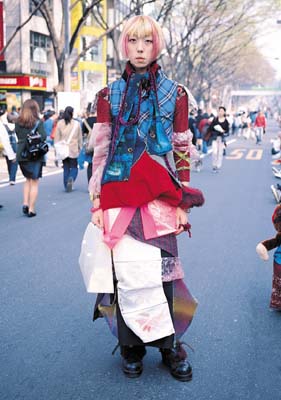The Power of Tokyo Street Style
Back to Contents of Issue: April 2003
|
|
|
|
by Lauren Sarti |
|
 IN THE CONSUMER-DAZED world of Tokyo, a group of teens are battling the wave of change taking place in Japanese subculture. They are the FRUiTS kids of Harajuku, whose cutting-edge street fashion caused a cultural revolution, inspiring a new generation of designers all over the world. The cult gained momentum in the mid-1990s, at the height of hokoten, or "pedestrian paradise," when Harajuku's main streets were a mecca for artists, musicians and trend worshippers of every kind. No longer willing to be slaves to designer labels, these kids created their own individual theme-based couture. The vessel for their ideas was photographer Shoichi Aoki's FRUiTS magazine. It gave these shopping rebels the power to reach kids all over Japan. The release of the FRUiTS book by Phaidon Press in 2001 gave these kids a worldwide following. Aoki says he was thrilled to have his work seen in Australia as part of the 2003 Sydney Festival. "I am proud of youth fashion culture in Japan. It is the only thing I can be proud of in present Japanese culture," he says. The first major exhibition of his work, titled "FRUiTS: Tokyo Street," drew huge crowds at Sydney's Powerhouse Museum. A 27-year-old named Nick said the FRUiTS work amazed him. "It's just so completely out there. These guys are pushing as far away from everything else as they can, which is really kind of cool," he says. Over 70 photographs of 15- to 20-year-olds taken between 1997 and 2002 create an explosion of neon color and urban intensity. You can flick through past issues of the docu-zine via CD-ROM and read wall-to-wall quotes by Aoki. "Because Western clothing has a short history in Japan ... having a different style is a kind of risk," one panel reads. Raymond, a 43-year old German visitor, says, "It reminds me of punk but more interesting." He studies a photo of Princess, who is obsessed with "body organs." "What does it mean?" he asks. A video installation introduces Aoki to viewers while another chronicles the complete history of Japanese fashion. A "gothic Lolita" costume is on display as well as a selection of influential pieces by Sailor Moon, Takuya Angel and Vivienne Westwood.
The FRUiTS kids stand out because of their dedication to a kind of consumer anarchy. The emphasis is on custom-made, remodeled pieces and recycled brands like 20471120. Aoki says it's the reaction to the fashion that holds the key. "Especially now, when the economy is facing a downturn, most of the adult community is being a little bit more conservative, so there is a tendency to push down or destroy things that are confrontational that come from youth culture," he says. Fashion genres range from punk, cyber, new-funk and wire accessory to wamono, where traditional dress such as kimono, obi belts and geta sandals are mixed with Western items. Japanese rock bands, human anatomy and manga are particular fixations. FRUiTS is a deliberate attempt by Aoki to keep Japanese street fashion alive. In 1998, Harajuku's main streets were re-opened to cars on Sundays after complaints about noise at the hokoten. Aoki says the loss of the hokoten is significant "because the concept of a public square did not exist in Japan." "I've been trying to return to Hokoten," he said. "But it is beyond my power. I will keep trying to find effective operations." What interests the West about Japan is reflected in many of these outfits: an obsession with urban living and the legacy of pop while still maintaining ancient customs. "The Japanese are making a collage and wearing it," says radio producer Tony Barrell, who is credited in Australia with opening the window on Japanese pop-culture in the 1980s with his radio show the Nippi Rock Shop on youth station 2JJJ FM. "The Japanese have always been good at borrowing technology and style from other countries, but what Westerners are fascinated by is the way they turn it into something else completely and make it look original." He adds: "It's all about individual self-expression, which is another fascinating contradiction. We are always told the Japanese are all the same. Those FRUiTS photos are irrefutable proof that there's a deep sense of almost rebellious individualism in the young Japanese psyche. Something worth watching out for in a nation that we are told is supposed to be stagnating." The Australian interest in Japanese art and its pop aesthetic has been escalating over the past 15 years. In 1993, Australians imported a paltry A$443,000, or JPY475,892, of Japanese art. Last year, this figure reached A$1.552 million, or JPY1.67 million -- not much, perhaps, but still the highest total in the past decade. In the 1990s, it was superstar artists such as Takashi Murakami who enthralled Australian audiences with his "super-flat" take on contemporary Japanese culture while Mariko Mori shared her pop sensibility with a fusion of ancient and futuristic images. More recently the works of a new generation of artists have been gaining ground. In 2002, over 68,000 visitors flocked to see "Neo-Tokyo: Japanese Art Now," at the Museum of Contemporary Art in Sydney -- an impressive turnout for Australian audiences. The senior curator of the show, Rachel Kent, says the art has an important message for the West. "On one hand, there is this obsession with technology and moving forwards in terms of material culture and consumer culture, but on the other hand, there is this very strong traditional history," she says. "You wonder how they co-exist, but of course they do." That's a cultural transmission that is being increasingly well received in the West. @ |
|
Note: The function "email this page" is currently not supported for this page.





